Cards, cards, flashcards / Karty, karty, kartičky

Yes, guilty – I have a tiny obsession with flashcards. I have been using them for many years already. Why?
Ano, přiznávám dobrovolně – mám menší obsesi s kartičkami. Používám je už mnoho let. Proč?
- one can think up tons of different activities, that will help spice up the process of learning
- you remember the words/phrases faster thanks to them
- when they have the right size, you can put them into your pocket and use them as a cheat sheet during the day
- when they are well thought through, they contain plenty of useful info that will help you
- if you want your cards to serve you for a long time, it’s a good idea to laminate them
- dají se s nimi vymyslet miliony různých aktivit, které okoření proces učení
- rychleji se díky nim zapamatovávají slova/fráze
- když mají správnou velikost, můžete si je dát do kapsy a používat je jako tahák během dne
- pokud jsou dobře vymyšlené, obsahují hodně informací, které vám pomůžou při učení
- chcete-li, aby vám dlouho dobře sloužily, je dobré je zalaminovat
Let’s have a look at the set of cards that I have created for the free e-book „How to learn 22 Czech verbs in 2 weeks“. This set includes 22 cards with verbs in present tense (in Czech as well as English).
Pojďme se teď spolu podívat na sadu karet, kterou jsem vytvořila pro e-book zdarma („How to learn 22 Czech verbs in 2 weeks). Tato sada obsahuje 22 kartiček se slovesy v přítomném čase (nejen v češtině, ale i v angličtině).

In the left part there is always a verb in the infinitive + all forms in the present tense. In the Czech version there are sometimes 2 forms.
Why? The first one is always the form that you can frequently hear when speaking with people (it’s not the most grammatically correct one). The second form is according to all grammar rules (but it might sound too formal sometimes).
V levé části je vždy sloveso v infinitivu + jeho tvary v přítomném čase. V české verzi jsou u některých sloves 2 tvary.
Proč? První je vždy ten tvar, který můžete často slyšet, když se bavíte s lidmi (není to tedy ten “učebnicově” nejsprávnější). Druhý tvar je gramaticky zcela správně (někdy ale může působit hodně knižně).
Why did I decide to do it in such a way? I would love people to learn the real Czech from my flashcards (materials) – Czech that is used among people – not the “textbook” version.
I wouldn’t like learners to find out after 2 years of learning that they aren’t able to communicate. The thing is that the majority of Czech people don’t use the “textbook” version in everyday life…
Proč jsem se tak rozhodla? Ráda bych, aby se lidé z mých karet (materiálů) naučili skutečnou češtinu, která se používá mezi lidmi – ne jen tu “učebnicovou”.
Nerada bych, aby po 2 letech učení zjistili, že se stejně nedokážou domluvit – většina Čechů totiž tou “učebnicovou” verzí v běžném životě opravdu nemluví…
Each verb is used in a short sentence/phrase. It’s a well known fact that a learner remembers words in context more (btw you learn not only the verb, but also word order, prepositional phrase, etc., which is extremely important in Czech).
Každé sloveso je použité i v krátké větě/frázi. Je dobře známým faktem, že si člověk líp pamatuje slova v kontextu (mimochodem neučí se tím jen samotné sloveso, ale i pořadí slov ve větě, s jakou předložkou se používá a spol., což je právě v češtině hodně důležité).
What else can be done with such cards?
A co se dá s takovými kartami ještě dělat?
- look at the picture, think up 3 adjectives and create the comparatives and superlatives
- the adjectives can be related to the particular topic as well: for example a picture with a car – topic: travelling/means of transport: (comparatives, superlatives: rychlý, rychlejší, nejrychlejší (fast, faster, the fastest) – drahý, dražší, nejdražší (expensive, more expensive, the most expensive) – spolehlivý, spolehlivější, nejspolehlivější (reliable, more reliable, the most reliable))
- are you able to use the past tense? Create a short story that will include the verb from the card in the past tense (for example What happened to Pete last week? What did I do last night? What I didn’t like as a kid…)
- think up a crazy headline for a newspaper article that would include the picture from the card (the crazier the better – čím bláznivější, tím lepší – your brain remembers nonsense much more than the boring stuff… and it’s definitely more enjoyable to have fun while learning ;))
- podívejte se na obrázek a vymyslete 3 přídavná jména a vystupňujte je
- můžou to být i přídavná jména, která se vztahují k určitému tématu: např. obrázek s autem – téma: cestování/dopravní prostředky: 3 přídavná jména: rychlý, drahý, spolehlivý (stupňování: rychlý, rychlejší, nejrychlejší – drahý, dražší, nejdražší – spolehlivý, spolehlivější, nejspolehlivější)
- umíte už minulý čas? vymyslete krátký příběh, který bude obsahovat sloveso z kartičky (např. Co se stalo Petrovi minulý týden? Co jsem dělal včera večer? Co jsem neměl rád/ráda jako dítě…)
- vymyslete nějaký bláznivý titulek pro článek do novin, ve kterém by byla uveřejněna fotka z kartičky (čím bláznivější, tím lepší – ptákoviny člověk nezapomíná… a navíc je fajn se u učení i bavit ;))
You will find more tips in my free e-book.
Další tipy najdete v mém e-booku zdarma.
Do you like using cards while learning a new language? What’s your favourite activity like?
Používáte rádi kartičky, když se učíte nový jazyk? Jaká je vaše oblíbená aktivita?
[fb_tlacitka]









